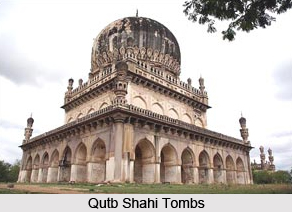 Qutb Shahi tombs are present in the Ibrahim Garden, which is near the Golconda Fort in Hyderabad. The central portion of each tomb contains a sarcophagus which overlaps the vault of burial in a crypt that is places below. The galleries belonging to the larger tombs consist of two stories while those of the smaller Qutab Shahi tombs possess a single storey. They comprised of beautiful domes which were ornamented with green and blue tiles.
Qutb Shahi tombs are present in the Ibrahim Garden, which is near the Golconda Fort in Hyderabad. The central portion of each tomb contains a sarcophagus which overlaps the vault of burial in a crypt that is places below. The galleries belonging to the larger tombs consist of two stories while those of the smaller Qutab Shahi tombs possess a single storey. They comprised of beautiful domes which were ornamented with green and blue tiles.
Location of Qutb Shahi Tombs
These tombs are existent at a distance of nearly a kilometre from the northern part of the outer wall of Golconda Fort and the Gate of the Gipsies, which is referred to as Banjara Darwaza. These are built on the top of an elevated platform. Pointed, sharp arches surround these tombs which is a combination of Hindu, Pashtun and Persian architectural styles. The interiors of the tombs are inlaid with intricate stonework and landscaped gardens decorate the premises of the tombs. Magnificent chandeliers, velvet canopies and carpetss adorn these historical tombs. Pedestals inside the tombs contain numerous copies of the holy Quran. Such Qutb Shahi tombs were fitted with golden spires, in order to mark a distinction with the tombs of the other royal members of this dynasty.
History of Qutb Shahi Tombs
During the regime of the emperors of the Qutb Shahi dynasty, their tombs were held in high esteem. However, the tombs were forgotten and neglected until the rule of Sir Salar Jung III, who had announced for their renovation in the earlier part of the 19th century. The garden which surrounded the tombs was spectacular and exuded a divine charm. All the rulers of the Qutb Shahi dynasty, except the very last Qutb Shahi sultan were buried in these famous tombs.
The tomb of Sultan Quli Qutb-ul-Mulk was built on a raised platform which measured about 30 metres. The chamber of the tomb is octagonal in shape and each of its side measured nearly 10 metres. Three graves are present in this particular tomb chamber, while 21 graves exist in the terrace that surrounds the tomb chamber. Naksh and Tauq scripts have been employed in the inscriptions that are present on the tomb of Sultan Quli Qutb Shah. This inscription addressed Sultan Quli as Bade Malik or Great Master, which was the same name that was used by the common masses of the Deccan to address the emperor. This tomb was constructed by Quli Qutb Shah in about 1543 A.D.
The tomb of Jamsheed, who was the son of Sultan Quli is also present near the tomb of Sultan Qutb Shah. This tomb was created in 1550 A.D and was constructed from black asphalt. It possesses two stories and lacks inscriptions. The tomb of Subhan, who was the son of Jamsheed is another tomb which is devoid of any inscriptions. Subhan was also known as `Chhote Malik` or the Small Master. The tomb of Sultan Quli Qutb Shah was created in 1580 and its size was bigger as compared to that of Sultan Quli`s tomb. There are two graves in the tomb`s main chamber and 16 on the terrace of the tomb, which belong to three daughters and six sons of Sultan Quli. Taqiuddin Muhammad Salih, Ismail and Ispahan were the renowned calligraphists whose works decorated the tombs.
The mausoleum of Sultan Mohammed Quli Qutb Shah is known to be the grandest of all the tombs of the Qutb Shahi dynasty. This tomb was constructed in 1602 A.D. and is placed on a terrace which is 4 metres in height. Naskh and Persian scripts are inscribed on the surface of the tomb. Yet another famous mausoleum is that belonging to Muhammed Qutb Shah and enamelled tiles have been utilized to decorate the tomb. It was built in 1626. Fatima Sultan`s tomb is characterised by a bulbous dome. She was Muhammed Qutb Shah`s sister. Near this tomb, the mausoleums of Kulthoom, are also located. Kulthoom was the grand-daughter of Muhammed Qutb Shah.
The tombs of two `hakims` or physicians who were present in the court of Sultan Abdullah, Abdul Jabbar Gilani and Nizamuddin Ahmed Gilani are also existent. They were constructed in 1651. The tombs of Taramati and Premamati are also present near the other tombs of the Qutb Shahi rulers. Nekam Khan`s tomb which was built in 1672 and Fadma Khanum`s tomb are the other important tombs. The western side of these tombs consist of the dargah of Hazrat Hussain Shah Wali, who was a Sufi saint. There exists a bath, which is located near the tomb of Mohammed Quli Qutb Shah and was created by Sultan Quli Qutb Shah. The mortuary is a reflection of the ancient Turkish and Persian baths.
Hayat Bakshi Begum`s mausoleum is yet another impressive tomb structure belonging to the age of the Qutb Shahi dynasty. Popularly termed as the `masjid of tombs of Golconda` and was constructed in 1666 A.D. Calligraphic inscriptions inside this structure add to its unique appeal. Two gigantic minarets are present around the prayer room. Bakshi Begum was Mohammed Quli Qutb Shah`s daughter and Muhammed Qutb Shah`s wife. She was lovingly addressed as `Ma Saheba`. The tomb garden was known as `Lagar-e-Faiz`.



















